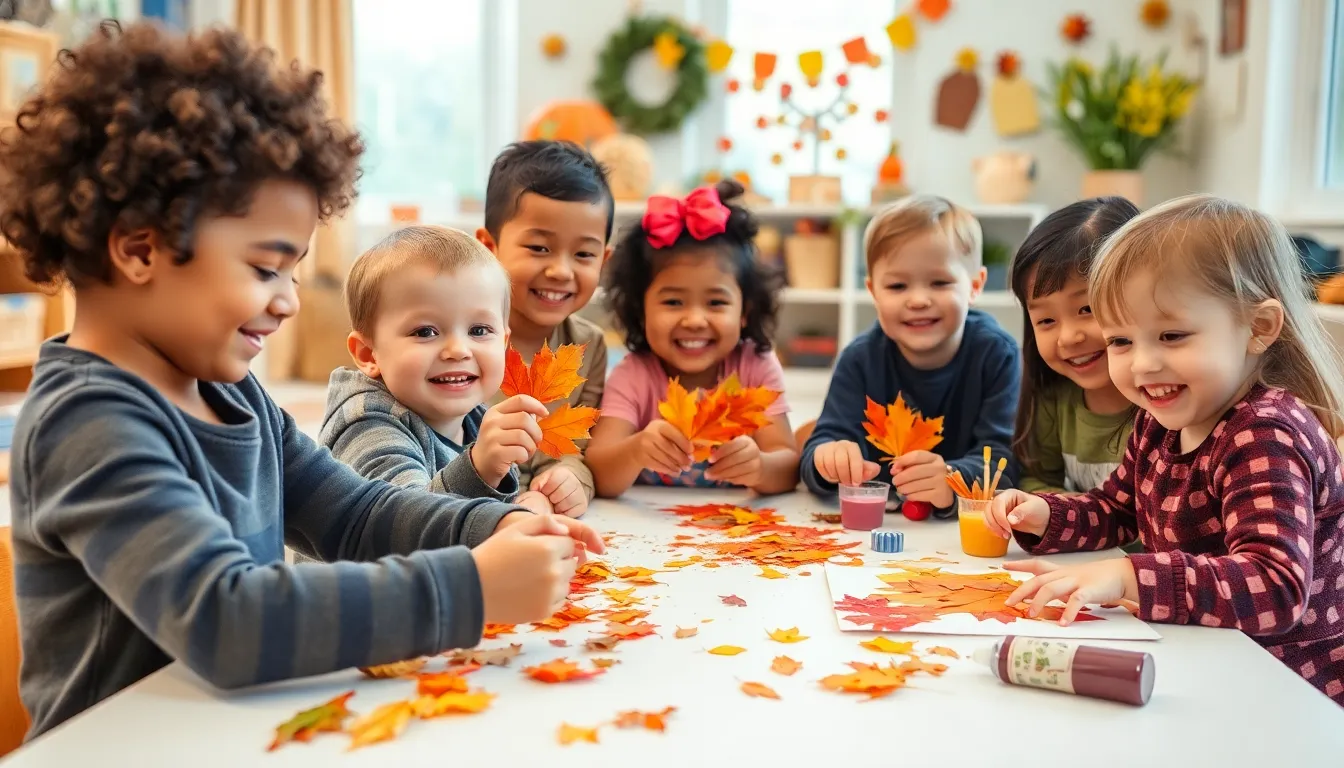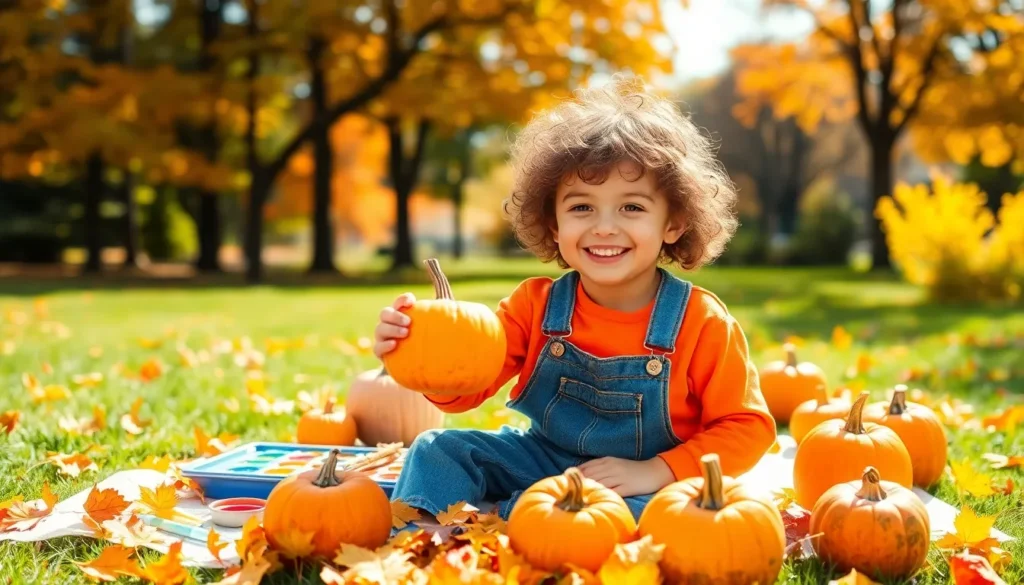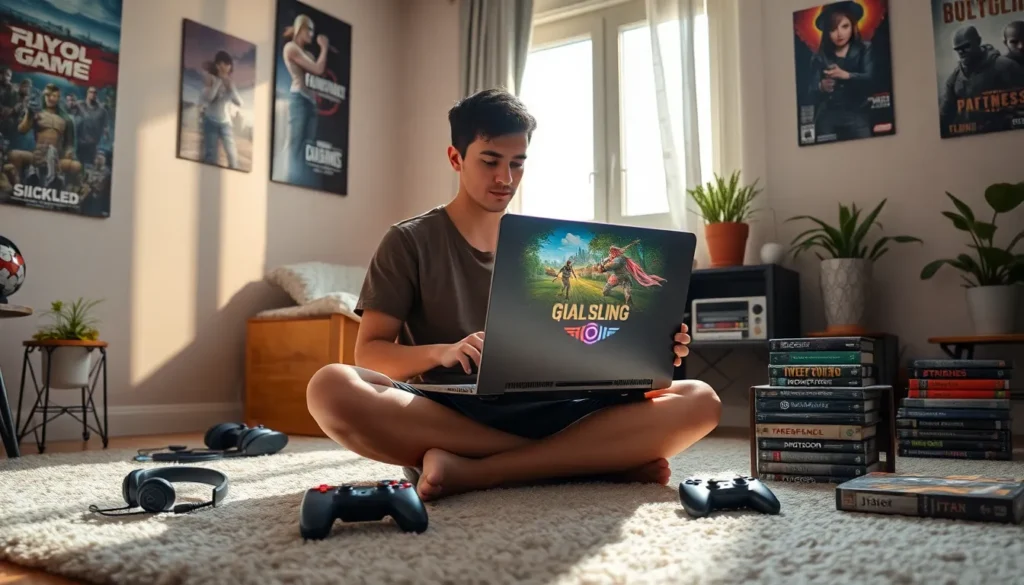Table of Contents
ToggleAs the leaves turn from vibrant green to a kaleidoscope of reds and oranges, it’s the perfect time for preschoolers to unleash their creativity with fall art projects. Imagine tiny hands transforming everyday materials into masterpieces that celebrate the season. Not only do these projects spark imagination, but they also keep little ones engaged while sneaking in some educational fun.
Overview of Fall Art Projects for Preschoolers
Fall art projects present numerous opportunities for preschoolers to explore creativity. Engaging in these projects enhances fine motor skills, as children manipulate materials such as leaves, paint, and clay. Seasonal themes provide a backdrop for exploration, encouraging learners to interact with colors and textures unique to fall.
Art projects can include leaf rubbings, where children place leaves under paper and use crayons to create prints. Painting pumpkins offers another hands-on experience. Preschoolers can use brushes or sponges to create vibrant designs. Creating collages from natural materials invites exploration. Children can collect acorns, twigs, and dried flowers to assemble unique artworks.
Incorporating storytelling into art enriches the experience. After completing their projects, preschoolers might share stories inspired by their creations. This fits seamlessly into learning objectives, as children practice language skills while expressing ideas.
In addition, using non-traditional materials encourages innovation. Items like old magazines, fabric scraps, and recycled cardboard can transform into imaginative pieces. These projects teach resourcefulness while highlighting environmental consciousness.
Teachers and caregivers can set up outdoor art stations, blending nature with creativity. Natural light enhances the artistic process, and the outdoors presents a dynamic setting. Facilitators can encourage collaboration, letting children work together and share materials, promoting social skills.
These art activities not only entertain but also stimulate cognitive development. They reinforce concepts such as shapes, colors, and patterns in a playful context. Through fall art projects, preschoolers experience meaningful learning that nurtures their creativity and curiosity.
Benefits of Art Projects for Preschool Development

Art projects significantly contribute to preschoolers’ overall development. Engaging in creative activities fosters imagination and offers educational rewards.
Enhancing Creativity
Creative expression plays a crucial role in a child’s development. Art projects empower preschoolers to explore their individuality. They learn to convey their thoughts through colors and shapes, developing unique artistic styles. By experimenting with various materials, children gain confidence in their abilities. Exposure to fall themes enriches their sensory experiences, stimulating their curiosity. Seasonal colors and textures spark inspiration, encouraging children to incorporate nature’s beauty into their artwork.
Motor Skill Development
Fine motor skills improve considerably through art projects. Activities involving cutting, gluing, and painting strengthen hand-eye coordination. Preschoolers enhance dexterity by manipulating different tools and materials. Working with small items like leaves or beads promotes precise movements. These skills are essential for everyday tasks like writing or buttoning clothes. Art projects also provide a fun way for children to practice gripping instruments. Ultimately, these hands-on experiences contribute to their physical development, transforming artistic expression into valuable life skills.
Easy Fall Art Projects
Engaging in fall art projects offers preschoolers an enjoyable way to explore creativity and seasonal themes. Below are two easy projects that can captivate young artists.
Leaf Collage
Creating a leaf collage allows preschoolers to explore textures and colors found in nature. Collect a variety of leaves in different shapes and sizes. Using a glue stick, children can attach leaves to a sturdy piece of paper or cardboard. This hands-on activity facilitates discussions about leaf colors and their origins. As children arrange the leaves, they develop fine motor skills and enhance spatial awareness. Adding personal touches, like markers or stickers, encourages individual expression, making each collage unique.
Pumpkin Painting
Pumpkin painting sparks excitement among preschoolers during the fall season. Choose small pumpkins for easy handling by tiny hands. Children can use acrylic or washable paints to decorate their pumpkins, experimenting with colors and patterns. This project offers opportunities to discuss pumpkin features like texture and color. As children paint, they improve their hand-eye coordination and practice control with brushes. Displaying their finished creations promotes a sense of accomplishment and encourages sharing their artwork with family and friends.
Educational Themes in Fall Art
Fall art projects for preschoolers promote essential educational themes. Children engage with colors, nature, and creativity while inspiring hands-on learning.
Exploring Colors
Colors transform in fall, presenting an array of rich hues for exploration. Preschoolers examine vibrant oranges, reds, and yellows as they create art. Engaging in color mixing activities encourages them to understand color relationships. Projects such as leaf collages allow kids to investigate various shades found in nature. They’ll gain representation skills by matching colors from leaves to their artwork. Discussing the color spectrum cultivates vocabulary, enhancing their language development alongside artistic expression.
Nature Connections
Connecting with nature provides valuable learning experiences. Art projects centered on seasonal elements encourage preschoolers to observe their surroundings. They’ll gather leaves, acorns, and other natural materials during walks. Crafting with these items fosters a deeper appreciation for the environment. Through activities like creating nature-inspired collages, children develop sensory skills and fine motor abilities. Discussing natural textures and patterns broadens their understanding of the world. These experiences promote curiosity, sparking interest in learning more about ecosystems and wildlife.
Tips for Successful Art Sessions
Successful art sessions depend on careful planning and responsiveness to preschoolers’ needs. Choosing appropriate materials and creating an inviting space enhances the overall experience.
Choosing the Right Materials
Selecting safe, non-toxic materials ensures that children remain safe while they create. Gather a variety of items like colored paper, markers, paint, and natural objects such as leaves and twigs to inspire creativity. Provide tools that encourage exploration; for instance, use brushes of different sizes and textures. Avoid overwhelming children with too many choices, as this may lead to frustration. Instead, limit options to a few engaging items, allowing them to focus and express their artistic vision. Prioritizing accessibility of materials encourages independence and confidence as they experiment.
Setting Up a Creative Space
Designing a dedicated space promotes creativity and focus during art projects. Arrange tables or surfaces at preschool-friendly heights, ensuring children can reach materials easily. Create an organized area with distinct zones for different activities—painting, cutting, and gluing. Including natural light and appealing decorations showcases their art and stimulates inspiration. Minimize distractions by choosing a quiet location. Setting clear boundaries for messy activities allows for exploration without excessive worry. This nurturing atmosphere supports patience and encourages children to dive into their creative endeavors.
Fall art projects offer preschoolers a wonderful way to express their creativity while developing essential skills. These activities not only ignite imagination but also provide valuable learning experiences that resonate with their natural curiosity.
By engaging in hands-on projects like leaf collages and pumpkin painting, children explore the beauty of the season while honing their fine motor skills. Each creation becomes a celebration of their individuality and artistic expression.
As they connect with nature and experiment with colors and textures, preschoolers cultivate a deeper appreciation for their environment. Embracing these fall-themed art projects enriches their educational journey and lays the foundation for lifelong creativity and learning.







